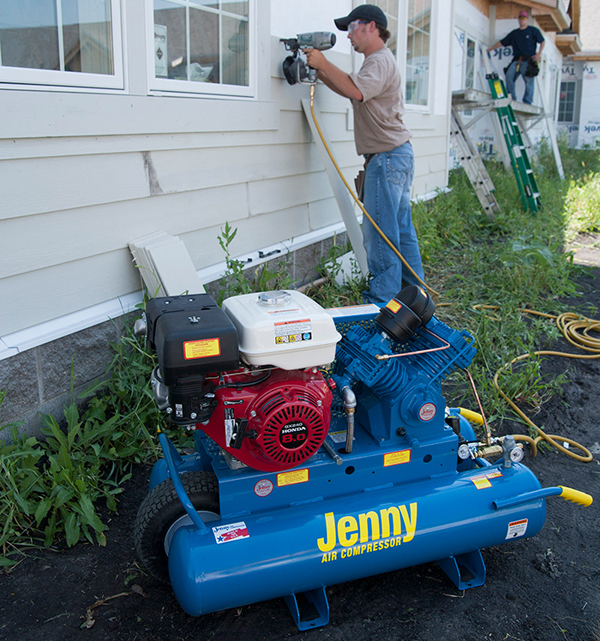Introduce Some Preventive Maintenance Steps To Extend The Life Of Your Compressor
Flipping through an air compressor owner’s manual, you will notice pages of preventive maintenance checks and troubleshooting tips, as well as caution notices for operator safety. Unfortunately, many don’t take the time to read—or even think about—the simple things that can help them get the best return on their equipment investment.
All those manual pages aren’t just a load of hot air. Even small, day-to-day tasks can make a difference in the life and repair cost of an air compressor. Nonetheless, preventive maintenance can be easily overlooked during the hustle of the workday.
In the rental industry, where equipment often withstands some of the harshest use, a compressor can last longer than one used on a construction site. This seems contradictory since renters take little “ownership” in equipment they only need for a short period of time. The key difference comes in the rental center’s preventive maintenance. Before each compressor goes out, rental centers typically do a run-through of the maintenance checks to ensure the unit isn’t returned nonfunctional within the hour, resulting in a lost day’s rental. These checks only take a few minutes, but they can add months—or even years—to the service life of a machine.
First, always begin with a clean compressor. While clean equipment looks better, it also will help improve maintenance because it will make it easier to detect leaks and broken or loose components. Next, move into the following preventive maintenance checks to help keep a compressor running strong for years to come.
Daily Maintenance
While a number of things should be checked before each compressor use, these daily maintenance tasks are among the quickest and easiest to perform. For starters, check the hoses for kinks, inspect the electrical wiring for cuts and fraying and examine the tubing and piping for damage. Ensure the connections in all of those areas are tight, and also tighten any loose nuts or bolts. Look over the controls, gauges, accessories and instruments, making certain there are no loose mountings or damage.
Begin each day’s use by checking the pump oil level. Disconnect the power source and place the compressor on a flat surface. Remove the oil fill plug and check the level, then insert a screwdriver into the crankcase. Inspect the oil on the screwdriver for signs of contaminants, such as water and dirt, and change the oil if any contamination is found. Otherwise, change the oil annually. If a gas engine powers the compressor, use this time to check the engine oil level, as well, which also should be changed annually.
Be sure to install the correct type of air filter for the day’s work. Using the wrong type of filter, or failing to use one at all, could bring on operating problems. A standard filter will trap dust particles based upon micron size, while a coalescing filter will remove water and oil from the air. For some applications, such as spraying paint, an air dryer should be used with the coalescing filter so that all moisture is removed from the lines. On the other hand, some tools function better with some moisture. When using a nail gun, for instance, an operator may want to add oil to the line with a lubricator.
Once starting the compressor, be aware of any unusual noises or vibrations, which would indicate a potential problem. Knocking or vibrating could indicate a worn connecting rod or piston pin, dirt on the piston or a loose flywheel or pulley. Chatter at the pressure switch or magnetic starter may indicate the switch needs to be adjusted or replaced. Any noise out of the ordinary typically indicates that something is wrong.
At the end of each day, if not more frequently, drain condensation from the air tanks. As always, begin by disconnecting the power source. If the unit is portable, move it into an inclined position with the drain at the lowest point. Slowly open the drain and bleed the air from the tank(s). When the pressure drops to 10 psi, the valves can be fully opened and the tank(s) drained. Keep in mind that the condensate may contain oil, so it should be collected and disposed of properly.
Compressors operating in high-humidity areas will need to be drained more frequently than those in dryer climates. Moist air also can take a toll on a compressor’s longevity if the situation isn’t appropriately addressed. Humidity may cause moisture to form in the pump and produce sludge in the lubricant, which will cause premature wear on the parts. When moisture begins to cause problems, an operator will typically notice that the lubricant looks milky or that condensation forms on the outside of the pump as it cools. The effects of humidity can be diminished by frequently draining the air tank and avoiding unheated storage areas since excessive moisture can build when moving a unit between temperature extremes. Increasing ventilation or operating the compressor for longer intervals also may help prevent moisture from forming in the pump.
